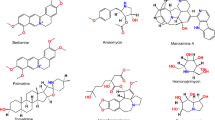Abstract
Stem barks of Anogeissus leiocarpus and Terminalia avicennoides widely used in Africa for treatment of some parasitic diseases were collected and made into methanolic extracts. The extracts were tested on four strains of promastigote forms of Leishmania in vitro. Solvent fractionation in aqueous, butanolic, and ethyl acetate layer indicated butanol and aqueous fractions to have a superior leishmanicidal activity. Chromatographic separation of the butanolic fraction on Sephadex LH-20 followed by nuclear magnetic resonance and correlation high-performance liquid chromatography revealed the presence of known hydrolyzable tannins and some related compounds—with castalagin as the major compound. The observed activity ranged from 62.5 to ≥150, 112.5 to ≥500, and 55 to >150 μg/ml for the crude methanolic extract, different solvent fractions, and the isolated compounds, respectively, on the four different Leishmania strains.



Similar content being viewed by others
References
Adjanohoun E, Ahyi MRA, Ake Assi L (1991) Contribution to ethno botanical and floristic studies in Western Nigeria. CSTR-OUA, p 220
Akendengue B, Ngou-Milama E, Laurens A, Hocquemiller R (1999) Recent advances in the fight against leishmaniasis with natural products. Parasite 6:3–8
Asres K, Bucar F, Knauder E, Yardley V, Kendrick H, Croft SL (2001) In vitro antiprotozoal activity of extract and compounds from the stem bark of Combretum molle. Phytother Res 15:613–617
Berman JD (1997) Human leishmaniasis: clinical, diagnostic and chemotherapeutic developments in the last 10 years. Clin Infect Dis 24:684–703
Bhat RB, Eterjere EO, Olapido VT (1990) Ethno botanical studies from Central Nigeria. J Econ Bot 44:382–390
Boelaert M, Le-Ray D, Van-Der SP (2002) How better drugs could change kala-azar controlLessons from a cost-effectiveness analysis. Trop Med Int Health 7:955–959
Camacho MR, Croft SL, Phillipson JD (2000) Natural products as sources of antiprotozoal drugs. Curr Opin Anti-Infect Investig Drugs 2:47–62
Chan-Bacab MJ, Peña-Rodríguez LM (2001) Plant natural products with leishmanicidal activity. Nat Prod Rep 18:674–688
Croft SL, Coombs GH (2003) Leishmaniasis—current chemotherapy and recent advances in the search for novel drugs. Trends Parasitol 9:502–508
Crump A (2006) New medicines from nature’s armamentarium. Trends Parasitol 22:51–54
Ephros M, Waldman E, Zilberstein D (1997) Pentostam induces resistance to antimony and the preservative chlorocresol in Leishmania donovani promastigotes and axenically grown amastigotes. Antimicrob Agents Chemother 41:1064–1068
Fournet A, Munoz V (2002) Natural products as trypanocidal, antileishmanial and antimalarial drugs. Curr Top Med Chem 2:1215–1237
Gbile ZO, Adayemi FA, Odewa TK (1990) Nigerian flora and its pharmaceutical potential no. 3. Mitteilungen des Instituts für Allgemeine Botanik 23b:1033–1038
Handman E (2001) Leishmaniasis: current status of vaccine development. Clin Microbiol Rev 14:229–243
Iwu MM, Jackson JE, Schuster BG (1994) Medicinal plants in the fight against leishmaniasis. Parasitol. Today 10:65
Kinjo J, Nagao T, Tanaka T, Nonaka G, Okabe H (2001) Antiproliferative constituents in the plant 8. Seeds of Rhynchosia volubilis. Biol Pharm Bull 24:1443–1445
Koehn FE, Carter GT (2005) The evolving role of natural products in drug discovery. Nat Rev/Drug Discovery 4:206–220
Lin T, Nonaka G, Nishioka I, Ho F (1990) Tannins and related compounds. CII. Structures of terchebulin, an ellagitannin having a novel tetraphenylcarboxylic acid (terchebulic acid) moiety, and biogenetically related tannins from Terminalia chebula RETZ. Chem Pharm Bull 38:3004–3008
Lira R, Sundar S, Makharia A, Kenney R, Gam A, Saraiva E, Sacks D (1999) Evidence that the high incidence of treatment failures in Indian kala-azar is due to the emergence of antimony-resistant strains of Leishmania donovani. J Infect Dis 180:564–567
Nonaka G, Nishioka I, Nishizawa M, Yamagishi T, Kashiwada Y, Dutschman GE, Bodner AJ, Kilkuskie RE, Cheng YC, Lee KH (1990) Anti-AIDS agents, 2: inhibitory effects of tannins on HIV reverse transcriptase and HIV replication in H9 lymphocyte cells. J Nat Prod 53:587–595
Seeram NP, Adams LS, Henning SM, Niu Y, Zhang Y, Nair MG, Heber D (2005) In vitro antiproliferative, apoptotic and antioxidant activities of punicalagin, ellagic acid and a total pomegranate tannin extract are enhanced in combination with other polyphenols as found in pomegranate juice. J Nutr Biochem 16:360–367
Shuaibu MN, Wuyep PT, Yanagi T, Ichinose A, Hirayama K, Tanaka T, Kouno I (2008) Trypanocidal activity of extracts and compounds from the stem bark of Anogeissus leiocarpus and Terminalia avicennoides. Parasitol Res 102:697–703
Taguri T, Tanaka T, Kouno I (2004) Antimicrobial activity of 10 different plant polyphenols against bacteria causing food-borne disease. Biol Pharm Bull 27:1965–1969
Tanaka T, Nonaka G, Nishioka I (1986a) Tannins and related compounds. XLI. Isolation and characterization of novel ellagitannins, punicacorteins A, B, C and D, and punigluconin from the bark of Punica granatum L. Chem Pharm Bull 34:656–663
Tanaka T, Nonaka G, Nishioka I (1986b) Tannins and related compounds. XLII. Isolation and characterization of four new hydrolyzable tannins, terflavins A and B, tergallagin and tercatain from the leaves of Terminalia catappa L. Chem Pharm Bull 4:1039–1049
Tanaka T, Ueda N, Shinohara H, Nonaka G, Fujioka T, Mihashi K, Kouno I (1996) C-glycosidic ellagitannin metabolites in the heartwood of Japanese chestnut tree (Castanea crenata Sieb. et Zucc.). Chem Pharm Bull 44:2236–2242
Vonthron-Senecheau C, Weniger B, Ouattara M, Tra Bi F, Kamenan A, Lobstein A, Brun R, Anton R (2003) In vitro antiplasmodial activity and cytotoxicity of ethno botanically selected Ivorian plants. J Ethnopharmacol 87:221–225
WHO (World Health Organization): Communicable disease surveillance and response [http://www.who.int/emc/diseases/leish/leisdis1.html]
Yang LL, Lee CY, Yen KY (2000) Induction of apoptosis by hydrolyzable tannins from Eugenia jambos L. on human leukemia cells. Cancer Lett 157:65–75
Acknowledgement
This work was supported by the Japanese Society for the Promotion of Science (JSPS). MNS was a JSPS fellow and wishes to thank JSPS for the opportunity given to conduct this research.
Author information
Authors and Affiliations
Corresponding author
Rights and permissions
About this article
Cite this article
Shuaibu, M.N., Pandey, K., Wuyep, P.A. et al. Castalagin from Anogeissus leiocarpus mediates the killing of Leishmania in vitro. Parasitol Res 103, 1333–1338 (2008). https://doi.org/10.1007/s00436-008-1137-7
Received:
Accepted:
Published:
Issue Date:
DOI: https://doi.org/10.1007/s00436-008-1137-7




